I’ve been working on a stats-driven piece that I’m hoping to have out soon here at Bounces, but I’ve been distracted and stuck on an unexpected topic I wanted to briefly address first: the image that’s been atop the WTA website for the last 12 hours and counting.1
It looks like this:
At first glance it perhaps looks innocuous: a side-by-side of two players, Iga Swiatek and Alexandra Eala, who are set for a rematch this week in Madrid after Eala’s stunning upset of Swiatek in the Miami Open quarterfinals last month.
But there’s a lot happening here once you look closer, so let’s take a look again, and get into the details:
What’s Wrong With These Pictures?
The images of both women were either made, or significantly edited, by some sort of generative AI, mashing and mangling real photographs that were taken of these two women into something new and unsettling, occupying the uncanny valley.
Swiatek’s Side
Let’s start on the left side of the image, with Swiatek.
The clearest telltale signs that the images on the WTA website were AI-made are in the brand logos, which are of course a big part of the business of professional tennis. Though it would seem basic, logos and text are often the things generative AI images struggle with most.
First, the logo on her hat in the WTA website image looks like a small blue flame—perhaps the logo of a natural gas company, I thought.
But if you look at actual photos of Swiatek from Wednesday in Madrid—taken by the WTA’s official photographer, no less—you can see that it’s actually just a boxed in version of the logo of her apparel sponsor, On.
AI couldn’t make out quite what it was on Swiatek’s hat in source images and guessed, incorrectly, and thus hallucinated some sort of flame (or plum or something—it’s nonexistent and imaginary so it’s up for interpretation).
The hat logo is perhaps subtle; the bit on Swiatek’s racquet is more obviously wonky:
The brand name of Swiatek’s racquet manufacturer is mangled and illegible; her fingers also perhaps appear gnarled into some uncomfortable scrunch. There’s also a strange ridge or bump at the top of the throat of Swiatek’s racquet that would never really be there.
Here’s what it should actually look like:
As you can see, the Tecnifibre brand name is very legible in real life, and of course that’s not by mistake: On and Tecnifibre both pay Swiatek big bucks to use their equipment and display their logos, which she dutifully does. If I’m her sponsors or her agents, I’m pretty furious that AI is anonymizing Swiatek’s sponsors like this, especially on the pretty prime real estate they could have had from many hours on the front of the WTA website.
One last note on Swiatek’s side of the image: the AI also made her teeth look yellower and more crooked than they are in real life, which just seems unfair. Who would ever run an image through AI to add cosmetic imperfections?
Eala Edits
For Eala’s side of the image, I believe I was able to find the original image which the Eala AI creation was based off of, again taken by the WTA’s official photographer during her semifinal match in Miami.
Here’s what the WTA website’s creation and the actual photograph look like side by side; I think even an untrained eye will be able to spot the differences very readily. It’s a fun—and then quickly creepy—spot the differences game.
Perhaps because the AI database has a lot fewer photographs of newcomer Alexandra Eala to train off of than it did for Swiatek, I don’t even think the image the WTA published is especially recognizable as Eala. Generously, it’s as if she was drawn from memory from someone who knew her when she was much younger, perhaps.
Aside from making Eala much more babyfaced, the WTA’s AI image also erases the gold chain around Eala’s neck and removes the navy blue nail polish from her thumbnail.
Again, fingers are often an AI weak spot, and the top of this fist is pretty strange.
Like on Swiatek’s image, some of the most severe mangling in Eala’s image is concentrated around the words and logos.
First, there’s the iconic Nike swoosh—in its tennis-centric NikeCourt configuration—which is melded by AI to something that looks nothing like the Nike swoosh (but a whole lot like Long Island).
And then there are Eala’s sleeve sponsors, two big Filipino brands:
Globe Telecom, which has sponsored Eala since she was just 8 years old, is garbled by the WTA’s AI into “ROLD.F”;
And then BPI (Bank of the Philippine Islands), which is rendered by the AI as something close to “Q:o|”
Here’s what the very legible BPI logo actually looks like, if you’re curious:
I contacted the WTA on Wednesday afternoon seeking clarification and explanation of their use of AI in editorial photographs, but have not yet heard back from them at time of publishing. (Update: I’ve added the statement the WTA sent over on Friday morning a few paragraphs down.)
I have not spotted any other obvious AI in WTA’s editorial photographs; they do use generative AI in social media sometimes (such as AI-generated fake action figures based on WTA players), which isn’t great, but I think at least when done previously it’s been for more frivolous purposes than a news article atop the WTA homepage.
Updates:
Thursday Morning Update:
About 16 hours or so after the strange AI image went up—and a few hours after the publication of this article—the WTA changed the image on its website to just a photo of Swiatek alone.
Friday Morning Update:
After I had reached out for comment, the WTA sent over this statement on Friday morning:
An image was originally created in a tool that put together the 2 photos and to fit the size of that position on our website.
Unfortunately, it did not render correctly and the cropping then distorted the photo.
I have to say that the WTA statement does not explain the whole picture (pun intended) whatsoever, and I’m left wondering what this unnamed “tool” was. Simple “cropping” doesn’t distort photos so much that it would, for example, change the text on a shirt sleeve from “Globe” to “ROLD.F”. I am not a professional photo editor, but I’ve put two images side-by-side many times—including often at Bounces, and even in this article several times—and this is just not a thing that happens in the process of resizing image files.
The most common question or comment I’ve gotten since this story went up—and I’ve gotten a lot of them—‘Why did the WTA do this? Don’t they have plenty of real photos they can use instead of using shoddy AI?’ And it’s a very basic question, but I still don’t know the answer.
After lots of thinking about it, my best guess is that the AI mangling of these two photos was unintentional, done by some WTA employee who did not have a good grasp of whatever program or AI they were using, and thought they were performing a simple photo-stitching task, but instead triggered various “upscale” or “enhance” or “optimize” type AI operations, functions which all sorts of software and interfaces are now pushing and foregrounding.
The WTA’s photo editor should know better, and they should have caught it once it happened, but I do think it was, on balance of probabilities, an accident born of incompetence rather than any sort of mischief or malice. But still, this should be a concerning lesson for whomever is currently in charge of the WTA website.
Why Does This Matter?
Generative AI is an inescapable part of life in 2025, especially on the internet, and I don’t think most people are paying nearly enough attention to how insidious and low-quality so much of it is. So much AI is being used and accepted so quickly without understanding how it works, or how much it’s taking the humanity, texture, and competence out of our culture.
I could say a whole lot more about the existential threats of AI at play here—and how much outsourcing of creativity and basic thinking people are willingly doing in the name of profit or just laziness or cutting corners—but in short: when it comes to choosing between humans or machines, I am on the side of humanity, and I think you should be, too.
It’s part of why I was so appreciative of Danielle Collins sounding a note of sympathy to line judges who lost their jobs in favor of Hawkeye Live, saying that “there’s a lot of jobs being taken away because of electronics.” Athletes, perhaps, have some of the most AI-proof jobs of all…until proven otherwise.
I’m especially sensitive to generative AI creep, I’m sure, because I’ve made my career as a writer who writes all my own words—and also works hard to find rights-free or fair use images for all the stories you read here at Bounces (I commissioned the Bounces and NCR logos from the beautifully full-of-life graphic designer Sinan Sadula).
But the recent trends are clear, and the long-term viability (or maybe even short-term if things continue accelerating) of writing as a career depends on audiences being discerning and educated about what’s real and what’s not, and what they can or can’t trust.
People in tech (or who specialize in cost cutting) seem to see generative AI as an irresistible omnipotent cure-all, and sometimes decision-makers and gate keepers who should know better don’t demonstrate discretion. I was pretty angry last summer when this issue suddenly crashed into tennis writing: Wimbledon started publishing banal AI slop blurbs on its app during last year’s tournament, to showcase some pretty subpar work by their longtime sponsor IBM. Wimbledon, to its credit, was responsive to the complaints about the shoddy product, but that was only one moment; it will take constant vigilance and appreciation of human work to stop the avalanche of AI from sweeping humanity and reality out of culture.
All of that alarmism is to say, of course, sincere thanks for reading and supporting this human’s work here at Bounces. Whatever mistakes I make here are my own, and I’m very appreciative and grateful to have the support of you wonderful fellow humans.
-Ben





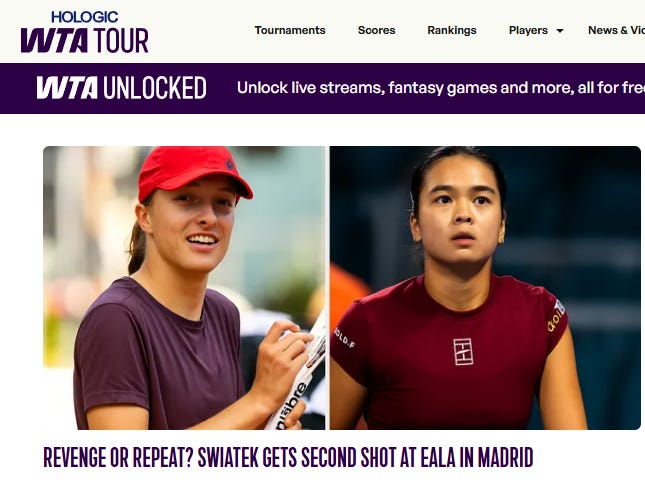
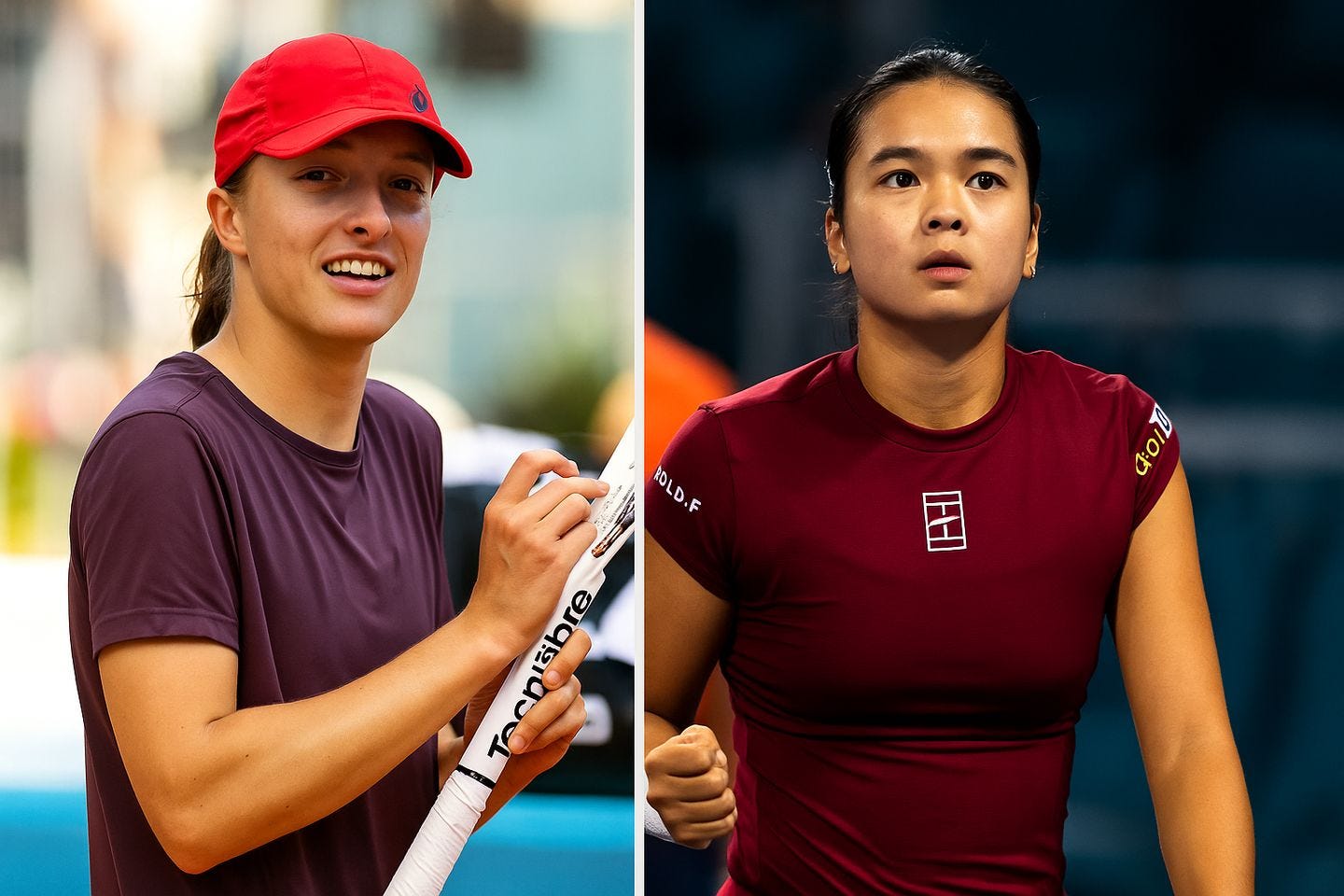
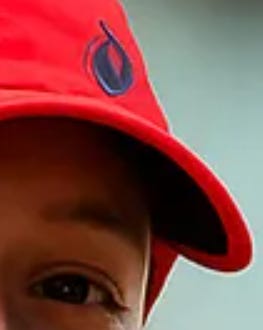
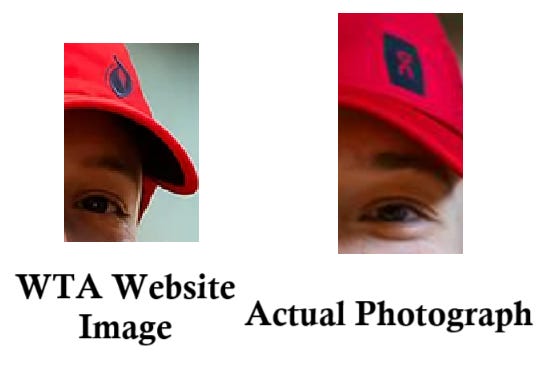
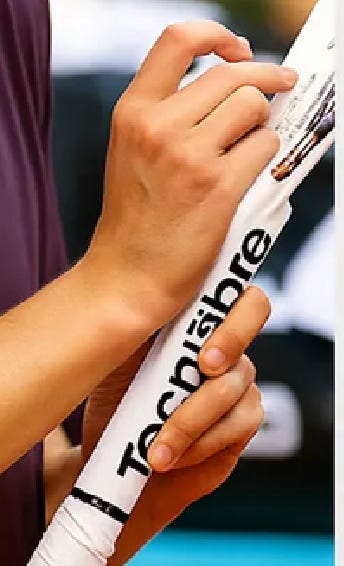
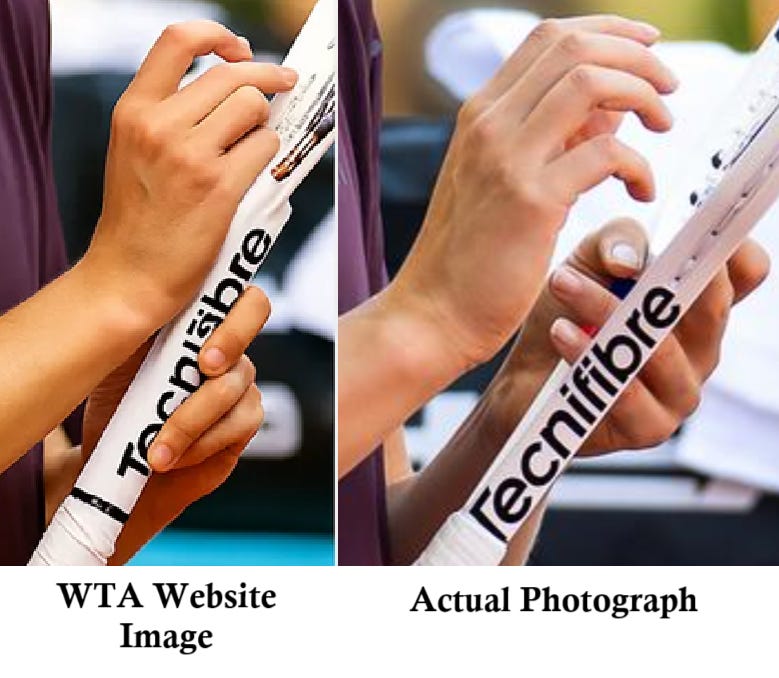


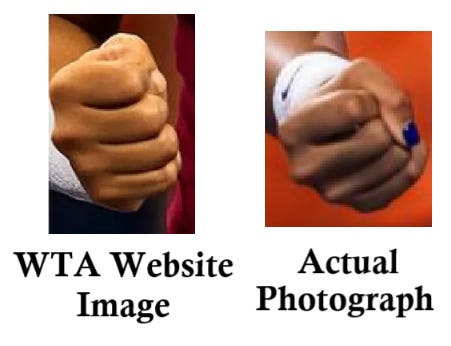


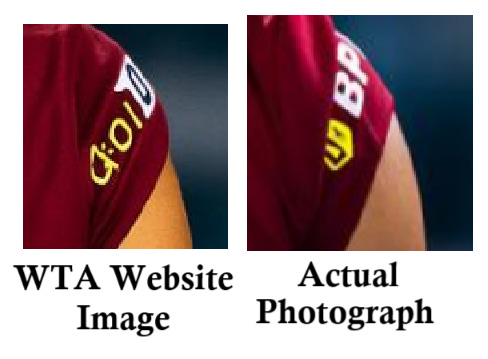

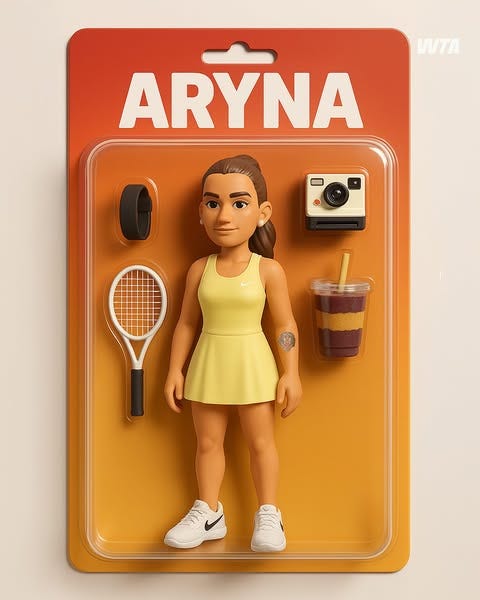
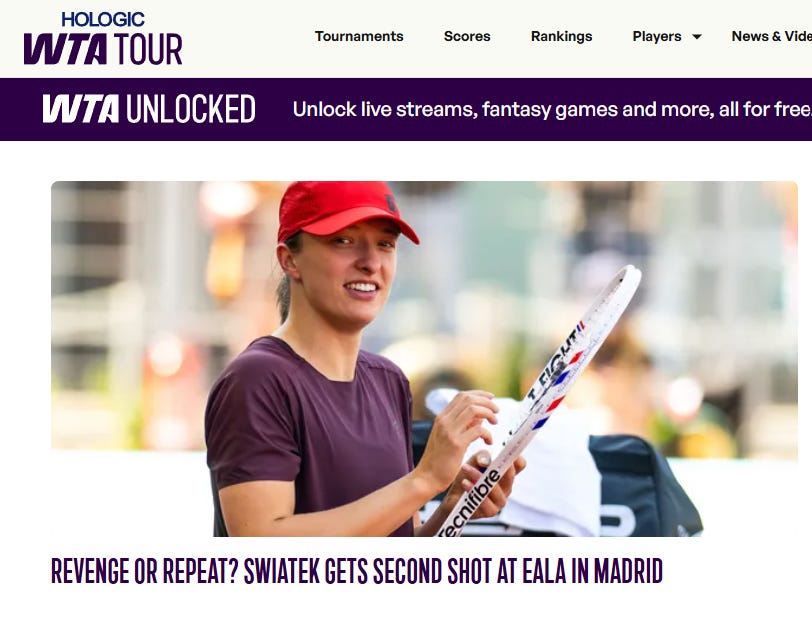


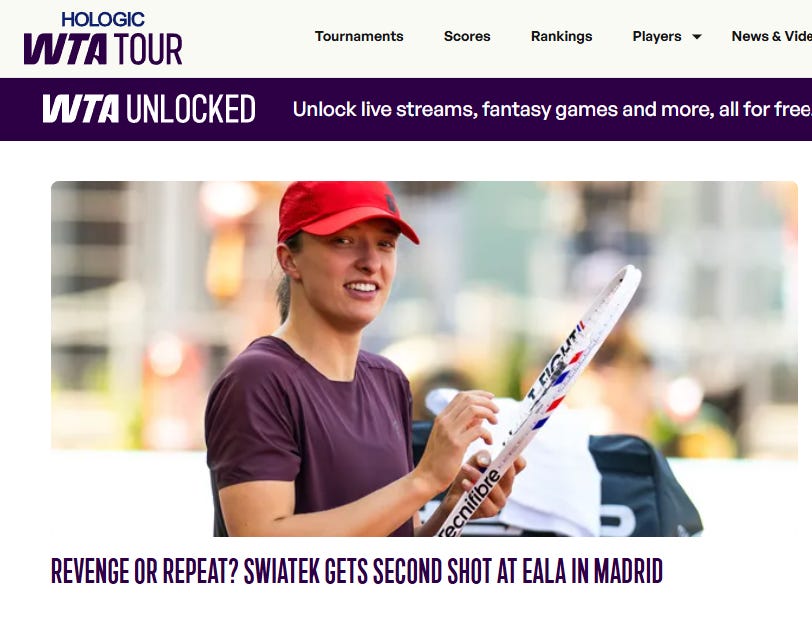
Simple question: why? How is this easier than picking a real recent photograph from a folder (from which I assume the WTA has an abundance to choose). What advantage is the photo editor reaching for by using AI?
Really struggling to understand why this was done at all, and especially bothered by altering of the players' faces and otherwise physical appearance. That photo really isn't identifiable as Alex. I'm so sick of having AI slop shoved in my face everywhere I go. I'm a software engineer and the amount of pressure I've gotten at work over the last 1-2 years to adopt these tools without a specific reason to do so or problem to solve has been incredibly frustrating.
There are a lot of things that bother me about the way we've embraced generative AI without equivocation, and I'll limit my comment to only 2. One of them is the way it devalues writers and other creatives (and is related to why I'm a subscriber here). Another is the environmental impact. A huge amount of computing power and demand on the electrical grid was used to morph these preexisting photographs into the uncanny valley for no good reason. I'm sure it seems like I'm overreacting, but I see something like this and I'm absolutely furious at the waste and the pointlessness of it. It fills me with an ennui that I struggle to shake. You've struck a chord with me today. Whether the WTA did this intentionally or it was a baked-in feature that they didn't ask for within an existing tool that they use, I'm so troubled that this is our new normal.